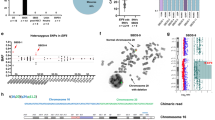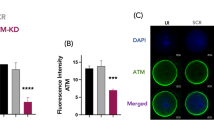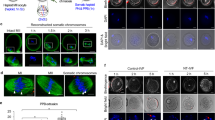Abstract
Mutations in mitochondrial DNA (mtDNA) are associated with severe human diseases and are maternally inherited through the egg’s cytoplasm. Here we investigated the feasibility of mtDNA replacement in human oocytes by spindle transfer (ST; also called spindle–chromosomal complex transfer). Of 106 human oocytes donated for research, 65 were subjected to reciprocal ST and 33 served as controls. Fertilization rate in ST oocytes (73%) was similar to controls (75%); however, a significant portion of ST zygotes (52%) showed abnormal fertilization as determined by an irregular number of pronuclei. Among normally fertilized ST zygotes, blastocyst development (62%) and embryonic stem cell isolation (38%) rates were comparable to controls. All embryonic stem cell lines derived from ST zygotes had normal euploid karyotypes and contained exclusively donor mtDNA. The mtDNA can be efficiently replaced in human oocytes. Although some ST oocytes displayed abnormal fertilization, remaining embryos were capable of developing to blastocysts and producing embryonic stem cells similar to controls.
This is a preview of subscription content, access via your institution
Access options
Subscribe to this journal
Receive 51 print issues and online access
$199.00 per year
only $3.90 per issue
Buy this article
- Purchase on SpringerLink
- Instant access to full article PDF
Prices may be subject to local taxes which are calculated during checkout



Similar content being viewed by others
References
Gropman, A. L. Diagnosis and treatment of childhood mitochondrial diseases. Curr. Neurol. Neurosci. Rep. 1, 185–194 (2001)
Haas, R. H. et al. Mitochondrial disease: a practical approach for primary care physicians. Pediatrics 120, 1326–1333 (2007)
Schaefer, A. M. et al. Prevalence of mitochondrial DNA disease in adults. Ann. Neurol. 63, 35–39 (2008)
Elliott, H. R., Samuels, D. C., Eden, J. A., Relton, C. L. & Chinnery, P. F. Pathogenic mitochondrial DNA mutations are common in the general population. Am. J. Hum. Genet. 83, 254–260 (2008)
Tachibana, M., Sparman, M. & Mitalipov, S. Chromosome transfer in mature oocytes. Nature Protocols 5, 1138–1147 (2010)
Tachibana, M. et al. Mitochondrial gene replacement in primate offspring and embryonic stem cells. Nature 461, 367–372 (2009)
Cowan, C. A. et al. Derivation of embryonic stem-cell lines from human blastocysts. N. Engl. J. Med. 350, 1353–1356 (2004)
Danan, C. et al. Evaluation of parental mitochondrial inheritance in neonates born after intracytoplasmic sperm injection. Am. J. Hum. Genet. 65, 463–473 (1999)
Lee, H.-S. et al. Rapid mitochondrial DNA segregation in primate preimplantation embryos precedes somatic and germline bottleneck. Cell Reports 1, 506–515 (2012)
Burgstaller, J. P., Schinogl, P., Dinnyes, A., Muller, M. & Steinborn, R. Mitochondrial DNA heteroplasmy in ovine fetuses and sheep cloned by somatic cell nuclear transfer. BMC Dev. Biol. 7, 141 (2007)
Wakayama, T. & Yanagimachi, R. The first polar body can be used for the production of normal offspring in mice. Biol. Reprod. 59, 100–104 (1998)
Susko-Parrish, J. L., Leibfried-Rutledge, M. L., Northey, D. L., Schutzkus, V. & First, N. L. Inhibition of protein kinases after an induced calcium transient causes transition of bovine oocytes to embryonic cycles without meiotic completion. Dev. Biol. 166, 729–739 (1994)
Forman, E. J. et al. Oocyte vitrification does not increase the risk of embryonic aneuploidy or diminish the implantation potential of blastocysts created after intracytoplasmic sperm injection: a novel, paired randomized controlled trial using DNA fingerprinting. Fertil. Steril. 98, 644–649 (2012)
Rienzi, L. et al. Consistent and predictable delivery rates after oocyte vitrification: an observational longitudinal cohort multicentric study. Hum. Reprod. 27, 1606–1612 (2012)
Moreno-Loshuertos, R. et al. Differences in reactive oxygen species production explain the phenotypes associated with common mouse mitochondrial DNA variants. Nature Genet. 38, 1261–1268 (2006)
Fisher, D. L., Brassac, T., Galas, S. & Doree, M. Dissociation of MAP kinase activation and MPF activation in hormone-stimulated maturation of Xenopus oocytes. Development 126, 4537–4546 (1999)
Runft, L. L., Jaffe, L. A. & Mehlmann, L. M. Egg activation at fertilization: where it all begins. Dev. Biol. 245, 237–254 (2002)
Mitalipov, S. M., Nusser, K. D. & Wolf, D. P. Parthenogenetic activation of rhesus monkey oocytes and reconstructed embryos. Biol. Reprod. 65, 253–259 (2001)
Gao, S., Han, Z., Kihara, M., Adashi, E. & Latham, K. E. Protease inhibitor MG132 in cloning: no end to the nightmare. Trends Biotechnol. 23, 66–68 (2005)
Kikuchi, K. et al. Maturation/M-phase promoting factor: a regulator of aging in porcine oocytes. Biol. Reprod. 63, 715–722 (2000)
Mandelbaum, J. et al. Effects of cryopreservation on the meiotic spindle of human oocytes. Eur. J. Obstet. Gynecol. Reprod. Biol. 113 (Suppl 1). S17–S23 (2004)
Smith, D. G. Genetic characterization of Indian-origin and Chinese-origin rhesus macaques (Macaca mulatta). Comp. Med. 55, 227–230 (2005)
Donnez, J. et al. Children born after autotransplantation of cryopreserved ovarian tissue. a review of 13 live births. Ann. Med. 43, 437–450 (2011)
Lee, D. M. et al. Live birth after ovarian tissue transplant. Nature 428, 137–138 (2004)
Acknowledgements
The authors would like to acknowledge the Oregon Health & Science University (OHSU) Embryonic Stem Cell Research Oversight Committee and the Institutional Review Board for providing oversight and guidance. We thank oocyte and sperm donors and staff at the Women’s Health Research Unit at the Center for Women’s Health, University Fertility Consultants and Reproductive Endocrinology & Infertility Division at the Department of Obstetrics & Gynecology of Oregon Health & Science University for their support and procurement of human gametes. The Division of Animal Resources, Surgery Team, Assisted Reproductive Technology & Embryonic Stem Cell Core, Endocrine Technology Core, Imaging & Morphology Core, Flow Cytometry Core and Molecular & Cellular Biology Core at the Oregon National Primate Research Center provided expertise and services for the nonhuman primate research. Hamilton Thorne Inc., donated an XYClone laser system for this study. We are grateful to W. Sanger and D. Zaleski for karyotyping services, C. Penedo for microsatellite analysis and J. Hennebold for consulting on metabolic assays. We are also indebted to A. Steele, R. Cervera Juanes and E. Wolff for their technical support. The human oocyte/embryo research was supported by grants from the OHSU Center for Women’s Health Circle of Giving and other OHSU institutional funds, as well as the Leducq Foundation. The nonhuman primate study was supported by grants from the National Institutes of Health HD063276, HD057121, HD059946, EY021214 and 8P51OD011092.
Author information
Authors and Affiliations
Contributions
M.T., P.A., J.J. and S.M. conceived the study, designed experiments and wrote institutional review board protocols. P.A., M.S. and N.M.G. coordinated recruitment of participants. P.A., K.M., D.B., D.L., D.W. and P.P. performed ovarian stimulation and oocyte recovery. M.T. conducted ST micromanipulations. M.S., K.M. and S.M. performed ICSI. M.T., M.S., J.W., D.M.S., N.M.G., R.T.-H. and E.K. conducted ESC derivation and characterization. S.G. analysed teratoma tumours. M.T., H.M. and D.M.S. performed DNA/RNA isolations, metabolic and mtDNA analyses. C.R., M.T., M.S.,H.-S.L., R.S. and S.M. conducted monkey studies. M.T., R.S., J.J., P.P. and S.M. analysed data and wrote the paper.
Corresponding author
Ethics declarations
Competing interests
The authors declare no competing financial interests.
Supplementary information
Supplementary Information
This file contains Supplementary Figures 1-10, Supplementary Tables 1-7, Supplementary Methods and Supplementary References. (PDF 1329 kb)
Rights and permissions
About this article
Cite this article
Tachibana, M., Amato, P., Sparman, M. et al. Towards germline gene therapy of inherited mitochondrial diseases. Nature 493, 627–631 (2013). https://doi.org/10.1038/nature11647
Received:
Accepted:
Published:
Issue Date:
DOI: https://doi.org/10.1038/nature11647



